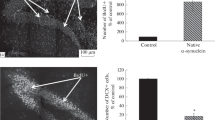Changes in the structure of the olfactory bulbs after long-term intranasal administration of pesticide rotenone, a classical inductor of parkinsonism, to rats were studied by the methods of immunomorphology. In rats intranasally receiving rotenone in a dose of 2.5 mg/kg every other day over 2 weeks, a decrease in the density of dopaminergic neurons and the area of astrocyte processes in the olfactory bulbs, activation of microglia in the glomerular layer, and enhanced α-synuclein phosphorylation and its accumulation in the bodies of mitral layer neurons were observed. The observed changes agree with the hypothesis on pathological α-synuclein transport via the olfactory route in Parkinson’s disease and confirm relevance of the rotenone model of Parkinson’s disease for studies of the pathological accumulation of α-synuclein.
Similar content being viewed by others
References
Voronkov DN, Dikalova YuV, Khudoerkov RM, Yamshchikova HG. Changes in the nigrostriatic brain structures during modeling of rotenone-induced parkinsonism (quantitative immunomorphological study). Annaly Klin. Eksper. Nevrol. 2013;7(2):34-38. Russian.
Voronkov DN, Khudoerkov RM, Dikalova YV, Sheloukhova LI. Quantitative Evaluation of Changes in the Striatal Astrocyte Axons in Simulated Parkinsonism. Bull. Exp. Biol. Med. 2016;160(4):505-509.
Illarioshkin SN. Modern view on etiology of Parkinson’s disease. Nevrol. Zh. 2015;20(4):4-13. Russian.
Del Tredici K, Braak H. Review: Sporadic Parkinson’s disease: development and distribution of α-synuclein pathology. Neuropathol. Appl. Neurobiol. 2016;42(1):33-50.
Emmrich JV, Hornik TC, Neher JJ, Brown GC. Rotenone induces neuronal death by microglial phagocytosis of neurons. FEBS J. 2013;280(20):5030-5038.
Ferris CF, Marella M, Smerkers B, Barchet TM, Gershman B, Matsuno-Yagi A, Yagi T. A phenotypic model recapitulating the neuropathology of Parkinson’s disease. Brain Behav. 2013;3(4):351-366.
Hawrylak N, Boone D, Salm AK. The surface density of glial fibrillary acidic protein immunopositive astrocytic processes in the rat supraoptic nucleus is reversibly altered by dehydration and rehydration. Neurosci. Lett. 1999;277(1):57-60.
He XJ, Nakayama H. Transiently impaired neurogenesis in MPTP mouse model of Parkinson’s disease. Neurotoxicology. 2015;50:46-55.
Li J, Gu CZ, Su JB, Zhu LH, Zhou Y, Huang HY, Liu CF. Changes in olfactory Bulb volume in Parkinson’s disease: a systematic review and meta-analysis. PLoS One. 2016; 11(2):e0149286. doi: https://doi.org/10.1371/journal.pone.0149286.
Mundiñano IC, Caballero MC, Ordóñez C, Hernandez M, DiCaudo C, Marcilla I, Erro ME, Tuñon MT, Luquin MR. Increased dopaminergic cells and protein aggregates in the olfactory bulb of patients with neurodegenerative disorders. Acta Neuropathol. 2011;122(1):61-74.
Prediger RD, Aguiar AS Jr, Matheus FC, Walz R, Antoury L, Raisman-Vozari R, Doty RL. Intranasal administration of neurotoxicants in animals: support for the olfactory vector hypothesis of Parkinson’s disease. Neurotox. Res. 2012;21(1):90-116.
Rojo AI, Cavada C, de Sagarra MR, Cuadrado A. Chronic inhalation of rotenone or paraquat does not induce Parkinson’s disease symptoms in mice or rats. Exp. Neurol. 2007;208(1):120-126.
Sasajima H, Miyazono S, Noguchi T, Kashiwayanagi M. Intranasal administration of rotenone in mice attenuated olfactory functions through the lesion of dopaminergic neurons in the olfactory bulb. Neurotoxicology. 2015;51:106-115.
Ubeda-Bañon I, Saiz-Sanchez D, de la Rosa-Prieto C, Martinez-Marcos A. α-Synuclein in the olfactory system in Parkinson’s disease: role of neural connections on spreading pathology. Brain Struct. Funct. 2014;219(5):1513-1526.
Ubeda-Bañon I, Saiz-Sanchez D, de la Rosa-Prieto C, Mohedano-Moriano A, Fradejas N, Calvo S, Argandoña-Palacios L, Garcia-Muñozguren S, Martinez-Marcos A. Staging of alphasynuclein in the olfactory bulb in a model of Parkinson’s disease: cell types involved. Mov. Disord. 2010;25(11):1701-1707.
Author information
Authors and Affiliations
Corresponding author
Additional information
Translated from Byulleten’ Eksperimental’noi Biologii i Meditsiny, Vol. 164, No. 8, pp. 232-236, August, 2017
Rights and permissions
About this article
Cite this article
Voronkov, D.N., Kutukova, K.A., Ivanov, M.V. et al. Immunomorphological Changes in the Olfactory Bulbs of Rats after Intranasal Administration of Rotenone. Bull Exp Biol Med 164, 203–206 (2017). https://doi.org/10.1007/s10517-017-3958-9
Received:
Published:
Issue Date:
DOI: https://doi.org/10.1007/s10517-017-3958-9



